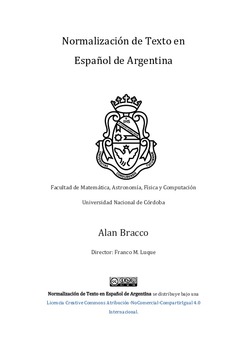| dc.contributor.advisor | Luque, Franco Martín, dir. | |
| dc.contributor.author | Bracco, Alan Gabriel | |
| dc.date.accessioned | 2019-07-23T14:16:35Z | |
| dc.date.available | 2019-07-23T14:16:35Z | |
| dc.date.issued | 2018 | |
| dc.identifier.uri | http://hdl.handle.net/11086/11707 | |
| dc.description | Tesis (Lic. en Cs. de la Computación)--Universidad Nacional de Córdoba, Facultad de Matemática, Astronomía, Física y Computación, 2018. | es |
| dc.description.abstract | En la actualidad la cantidad de datos que consume y genera una sola persona es gigantesca. Los datos cada vez son más, ya que cualquiera puede generarlos. Esto trae consigo un aumento en el ruido que hay en esos datos. Es por eso que el texto de las redes sociales se caracteriza por ser ruidoso, lo que es un problema cuando se quiere trabajar sobre ellos. En este trabajo construimos un corpus de tweets en español de Argentina. Recolectamos un conjunto grande de tweets y luego los seleccionamos manualmente para obtener una muestra representativa de los errores típicos de normalización. Luego, definimos criterios claros y explícitos de corrección y los utilizamos para proceder a la anotación manual del corpus. Además, presentamos un sistema de normalización de texto que trabaja sobre tweets. Dado un conjunto de tweets como entrada, el sistema detecta y corrige las palabras que deben ser estandarizadas. Para ello, utiliza una serie de componentes como recursos léxicos, sistemas de reglas y modelos de lenguaje. Finalmente, realizamos experimentos con diferentes corpus, entre ellos el nuestro, y diferentes configuraciones del sistema para entender las ventajas y desventajas de cada uno. | es |
| dc.description.abstract | Nowadays, the amount of data consumed and generated by only one person is enormous. Data amount keeps growing because anyone can
generate it. This brings along an increment of noisy data. That is why social network text is noisy, which is a problem when it is needed to work on it.
Here, we built a corpus of tweets in argentinian spanish. We collected a big set of tweets and we selected them manually to obtain a representative sample of common normalization errors. Then, we defined explicit and clear correction criteria and we used it to continue with the manual corpus annotation.
Besides, we present a text normalization system that works on tweets.
Given a set of tweets as input, the system detects and corrects words that need to be standardized. To do that, it uses a group of components as
lexical resources, rule-based systems and language models.
Finally, we made some experiments with different corpus, among them, the one we built, and different system configurations to understand each one’s advantages and disadvantages. | en |
| dc.language.iso | spa | es |
| dc.rights | Atribución-NoComercial-CompartirIgual 4.0 Internacional | * |
| dc.rights.uri | http://creativecommons.org/licenses/by-nc-sa/4.0/ | * |
| dc.subject | Procesamiento de lenguaje natural | es |
| dc.subject | Inteligencia artificial | es |
| dc.subject | Natural language processing | es |
| dc.subject | Artificial intelligence | es |
| dc.subject | Machine translation | es |
| dc.subject.other | Normalización de texto | es |
| dc.subject.other | Recursos lingüísticos | es |
| dc.subject.other | Redes sociales | es |
| dc.subject.other | Texto ruidoso | es |
| dc.subject.other | Twitter | en |
| dc.subject.other | Text normalization | en |
| dc.subject.other | Linguistic resources | en |
| dc.subject.other | Argentine spanish | en |
| dc.subject.other | Noisy text | en |
| dc.subject.other | Social networks | en |
| dc.title | Normalización de texto en español de Argentina | es |
| dc.type | bachelorThesis | es |





